In this science guide, kids can learn all about force and motion and the relationship between them.
What is Force?
An invisible action leading to the motion of an object to a new position from its original position is called Force. It is a vector product, as it has both magnitude and direction.
Examples: Electric force, Nuclear force, Spring force, etc.
Magnitude is the amount of force applied; while
Direction gives the course of action.
Represented by ‘F’.
Formula:
F = ma
Where, F is force,
m is mass, and
a is acceleration.
Also, acceleration is given by:
a = v/t
Where, v is velocity and
t is time.
Therefore, force can also be expressed as:
F = mv/t
Units: SI (Standard International) system – Newton (N)
Cgs (Centimetre Gram Second) system – kg.m/s2 or dyne Now, based on magnitude and direction, the force causes two things
(i) Speed change – increase or decrease.
(ii) Directional change – continues in the same route as the original or a different path.
Changes in speed and direction contribute to the following results –
- Move a resting object.
- Increase or decrease the speed of an already moving object.
- Stop the motion of an already moving object.
- Change its direction with respect to the speed and shape/size of the object.
Types of Forces
Since force has magnitude and direction, based on these, it is divided into two types –
- Contact Forces
- Non-Contact Forces
1. Contact Forces
This type of force causes motion through contact, either directly or indirectly.
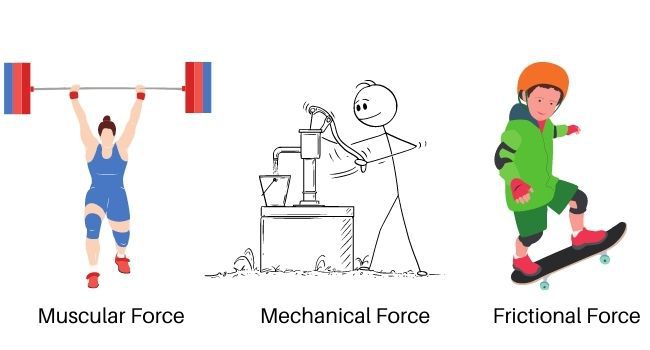
Examples:
- Muscular Force- muscles being the medium here.
- Mechanical Force- the medium could be a pulley or a hinge.
- Frictional Force- most important, acts between two surfaces in an opposing fashion.
2. Non – Contact Force
This type of force causes motion through space in the absence of contact.
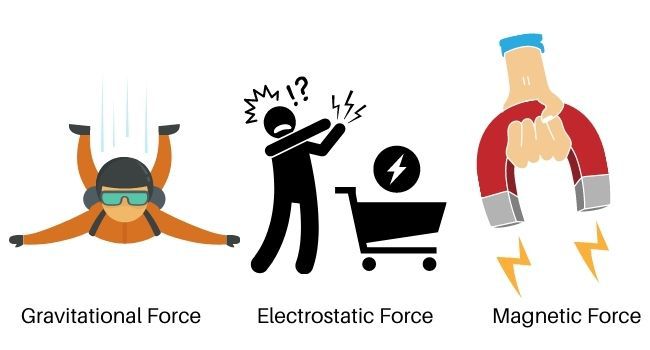
Examples:
- Gravitational Force- due to natural gravity.
- Electrostatic Force- occurs because of difference in charges.
- Magnetic Force- between opposite poles.
Types of Contact Forces
1. Frictional Force
Friction is one of the vital forces in the world of motion. Even in our daily life activities, we witness it.
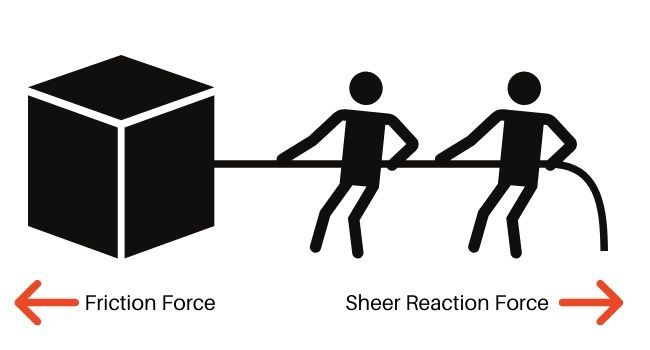
Represented as – ‘Ffrict’.
Examples: Motion of wheels on the road of a car while driving.
Movement of pen nip against the paper while writing.
Factors that may or may not affect friction are –
- Texture of both surfaces.
- Amount of force applied.
- Angle of force applied.
- Position from which force it is applied.
Formula:
Ffrict = μ . Fnorm
Where, Ffrict is frictional force,
μ is the coefficient of friction, and
Fnorm is normal force.
It is further classified into two types based on solid and liquid/gaseous surfaces –
- Dry Friction
- Fluid Friction
- Dry Friction
This is only between solid surfaces and strictly does not involve any liquids or gases.
Depending upon the varying solid surfaces that exist, it is again divided into four types-
- Static Friction – both solid surfaces are in motion.
E.g., Sliding a box on concrete.
- Kinetic Friction- both solid surfaces are not in motion.
E.g., Pushing a table.
- Rolling Friction- force resists the rolling motion.
E.g., Rolling of a basketball on the ground.
- Sliding Friction- only one side of the object is in contact
E.g., Pushing a box on a table.
2. Fluid Friction
This is only between liquid/gaseous surfaces and strictly does not involve any solids.
The resistance between two such surfaces gives rise to fluid friction. It acts against the natural flow of the substance like a hurdle. The high viscosity of a substance indicates its high resistance.
E.g., Water moving against the body of a swimmer.
2. Applied Force
It refers to the force applied either by a person to an object or by an object to another object. The amount of applied force depends upon the mass of the body/object.
Represented as – ‘Fapp’.
Examples:

(i) In the first case, the person is applying force forward, i.e., away from himself (the red arrow indicates the direction).
(ii) In the second case, the person is applying force backward, i.e., towards himself (the red arrow indicates the direction).
3. Normal Force
When two surfaces are in contact, they exert a normal force perpendicular to each other.
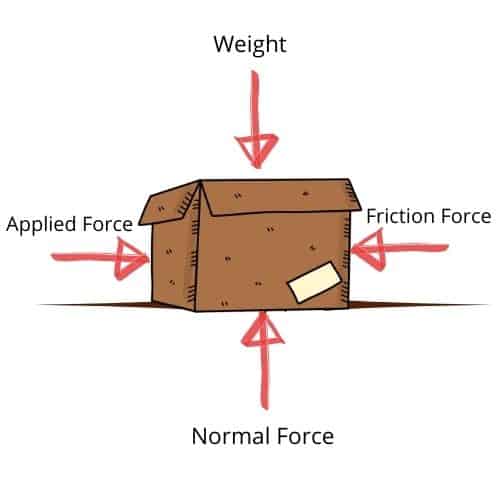
Represented as – ‘Fnorm’.
Formula:
Fnorm = mg
Where, Fnorm is normal force,
m is mass, and
g is gravitational force.
The normal force may change depending upon the following three conditions if an additional force is acting. The three types are-
(i) Downward on the falling object –
Fnorm = mg + F sin θ
Where, Fnorm is normal force,
m is mass,
g is gravitational force, and
θ is the angle with which the object moves downward
(ii) Upward on the falling object –
Fnorm = mg – F sin θ
Where, Fnorm is normal force,
m is mass,
g is gravitational force, and
θ is the angle with which the object moves upward.
(iii) At an inclined angle –
Fnorm = mg cos θ
Where, Fnorm is normal force,
m is mass,
g is gravitational force, and
θ is the angle of the inclined surface.
4. Air Resistance Force
This force comes into existence when an object is moving in the air, and that air resists the force of the object and moves in the opposite direction. The faster the motion, the increased the air resistance force is. Primarily used in Aeronautics.
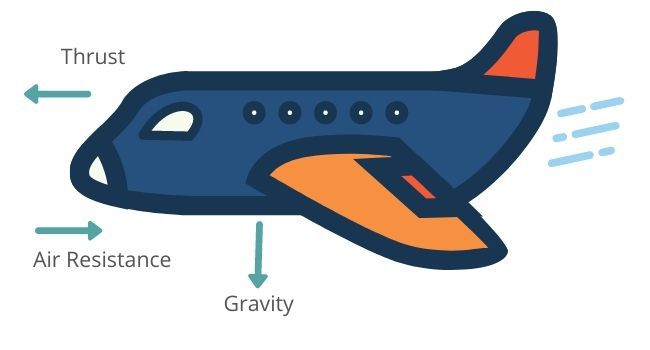
Represented as – ‘Fair’.
Formula:
Fair = cv2
where, Fair is the air resistance force,
c is force constant, and
v is velocity.
5. Tension Force
In the above picture, the force along the object’s length is spring, string, or any other flexible object. Only one of the two objects is flexible, while the other is rigid.
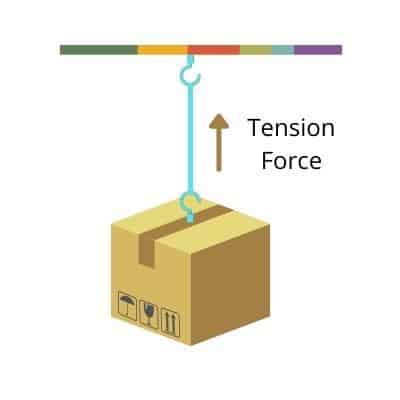
Represented as – ‘T’.
Formula:
T = mg + ma
Where, T is tension force,
m is mass,
g is gravitational force, and
a is acceleration.
Some of the characteristics of tension force are mentioned below –
- It is an action-reaction force, meaning if an action is performed, an equal reaction is expected.
- Throughout the spring, the tensional force varies.
- At one endpoint, tensional force exists, and at the other endpoint weight of the object exists.
- It is a pulling force and not a pushing force, as it is often misunderstood.
- Tension acts in the opposite direction of gravitational force.
6. Spring Force
When a force is applied on a spring to either compress it or stretch it, the spring exerts an equal force, and that force is called Spring Force.
In a compressed or stretched state, it is displaced from its original state, and when no force is subjected to it, it returns to equilibrium.
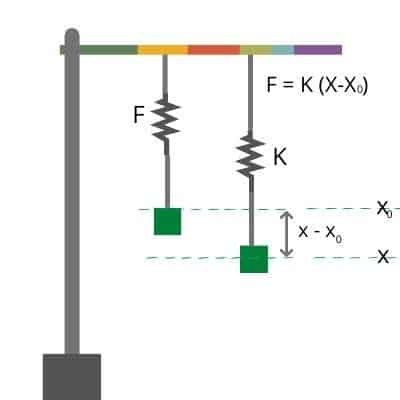
Represented as – ‘Fspri’.
Formula:
Fspri = k (x – x0)
Where, Fspri is spring force,
k is spring constant,
x is the displacement of spring from its original position, and
x0 is the original position.
Which Type of Force Exists for Every Other Force?
Every action has an equal and opposite reaction, whether you scribble in your friend’s notebook and they do the same in your notebook or as seen in physics when there is any kind of interaction between two objects in space.
So, the force which exists for every other force is a reactive force. Reactive forces are either along the force applied or against the force applied. In most cases, it is against, and several other additional factors add to the reactive force, which are initially absent in the applied force.
Force Which Resists All Motion
In other words, motion can be described as any and every kind of movement. It ranges from twisting a key in its lock to flowing water in a river. All these movements are a part of the motion.
Motion is a typical hero who wins every battle without any losses; however, it loses the battle miserably when it comes to a particular villain known as ‘friction.’ Therefore, Friction is the force that resists all motion.
Types of Forces in Biomechanics
Biomechanics is another one of the many vital aspects of force. It encompasses all kinds of structural and functional motions induced by various forces, from as minute as cell organelles to as big as muscles in humans. All these constitute biomechanics.
The term biomechanics is self-explanatory, not too difficult to understand the meaning. The intersection of physics and biology lead to the formation of ‘biophysics’ under which ‘biomechanics’ is a sub-branch.
There are 4 significant forms of biomechanics, and this division is as follows –
1. Motion Forces
These are further classified as:
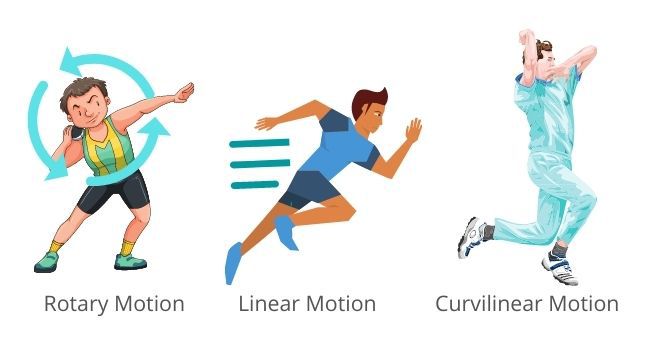
- Rotatory Motion
Also called ‘angular motion’ occurs about an axis that passes or does not pass through a body. It is one of the two forms of human motion.
Examples:
- Gymnast- axis does not pass through the body.
- Ice Skater- axis passes through the body.
- Extremities of the Human Body- here, joints act as axes.
2. Translatory Motion- Also called ‘linear motion’ occurs in a straight line. It is the second form of human motion.
Example:
- Sprinter- runs in a straight line.
3. Curvilinear– It is lesser known in biomechanics. It refers to the motion in a curved path.
Example:
- Bowler- bowling action.
2. External Forces
These are further classified as:
- Gravity
The natural gravitational force pulls the human body towards itself, and hence our body always remains on the ground. The exceptional cases require a force greater than the gravitational force to pull/lift the body.
Example:
- When we jump in the air, we immediately fall on the ground due to gravity.
2. Wind
Strong winds can influence certain motions. These may induce a motion from rest altogether or add on to the already existing force.
Example:
If you stand at the topmost floor/terrace of a skyscraper, you will experience strong winds pushing you.
3. Objects
Apart from naturally existing forces like gravity and situational forces like winds, certain objects are also present, which take part in imparting/exerting force upon the human body.
Example:
- If you visit an amusement park and sit on a Ferris wheel, you will experience forces while the ride is moving due to the cabin’s movement.
4. Other People
People interaction is also one of the sources of external forces.
Example:
- When a martial artist kicks his opponent.
3. Internal Forces
These are further classified as:
- Muscles
Muscular motion is the most basic motion in a human body. Even when you are reading this article, you are performing muscular movement of your eyes.
Example:
- Exercise- push-ups, burpees, jumping jacks, etc., all these are a part of muscular motion.
2. Connective Tissue (elastic)
Elastic connective tissue is a broadened category. It includes ligaments, tendons, cartilage (ears and nose), and adipose (fat) tissue. Any movement in these accounts for internal force causing motion.
Example:
- Running- on a treadmill or a track incites ligament and tendon motion.
3. Bone
Skeletal motion is another one of the basic motions. They are fundamental to us, without which we are immobile.
Example:
- Basic Locomotio – walking, talking, eating, picking, etc.
4. Reactionary Forces
These are further classified as:
- Ground Reactions
It means the force exerted by the human body when in direct contact with the ground. Also, the ground too exerts an equal and opposite amount of force, keeping the body at rest.
Example:
- Standing/Sitting – on the ground.
2. Joint Reactions
These reactions occur when force is applied to a particular joint(s) to move from one place to another or change positions.
Example:
- Hip Joint- climbing stairs.
- Knee joint- bicycling.
- Shoulder joint- playing badminton.
3. Gliding/Shear Reaction
The smooth movement of a limb, primarily your foot, is referred to as Gliding/Shear Reaction.
Example:
- Walking – movement of the foot.
Forces at Home
A house is a home to many physical interactions between two bodies or two objects. A person performs numerous actions that are either applied forces or the result of applied forces, i.e., frictional forces. All these are interconnected and interrelated.
Some of these examples are mentioned below –
- Frictional Force
- When you push your bed forward.
- When you pull the suitcase of clothes, you need it from under the bed.
- Applied Force
- When you push the mouse while using your PC.
- When you clean the study table with a wet cloth.
- Normal Force
- The Television kept on the table
- The Fridge placed on the ground
- Air Resistance Force
- The blades of the ceiling fan when you switch it on.
- The blades of the exhaust fan when you turn it on while frying food.
- Tension Force
- The chandelier hanging from the ceiling in your drawing-room.
- The wind chimes hanging above your bed.
- Spring Force
- The clicking of your pen when you are about to write on paper.
- The twisting of your automatic stove knob.
What is Motion?
Fundamentally, motion is a change in position.
Now, this change is inclusive of many factors like-
- Distance- length between the original position and final position.
- Displacement- shortest distance between the original position and final position.
- Speed- rate at which the distance is covered at a particular time.
- Time- period during which motion has taken place.
Examples:
- Flying in an airplane from one destination to another.
- Walking from your bedroom to the kitchen.
- Playing cricket with your flatmates in the common ground.
Laws of Motion
The famous Isaac Newton derived the rudimentary Laws of Motion we use in both theoretical and practical work. They were not so easily formed as they are thought to be. Going through countless failures and dustbins full of papers, we were finally given the three commandments of motion. They are –
1. First Law
It states that a resting object will stay the same unless an external force is applied, and a moving object keeps on moving unless an external force is applied either to stop the continuing motion or increase the speed/change the direction of the action already occurring.
Example: A Football rests until kicked;
A moving Football keeps moving and may even change direction when kicked again from a different direction, or comes to a stop if you place your foot against it.
2. Second Law
It states that an external force acting on an object, whether in rest or motion, is equal to the product of that object’s mass and acceleration.
Derivation:

Example: A moving Football moves with even more acceleration when an external force is applied.
3. Third Law
It states that a reaction force mandatorily accompanies every action force applied. It can vaguely be translated as “Tit for Tat.”
Whenever two objects come in contact, they exert equal and opposite forces towards each other. This is because of the difference between the two surfaces in structure, mass, and many other factors.
Example: When kicked with a certain amount of force against a wall, a Football comes back with the same force and velocity as when hit.
Types of Motions
Each object in nature has a different orientation, whether it is a subatomic particle or the Sun. The variations in these objects structurally and physically led to the categorization of motion into 3 main forms. They are-
1. Linear Motion
It is defined as the movement of objects/particles from one point to another in a straight or a curved line.
There are two forms of linear motion-
- Rectilinear Motion- straight-line motion.
E.g., A bus moving along a straight road.
- Curvilinear Motion- curved motion.
E.g., A bus moving along a curved road.
2. Rotatory Motion
It is defined as the movement of objects/particles by rotating on their axis.
Example: The rotation of a planet on its axis in the solar system.
3. Oscillatory Motion
It is defined as the movement of objects/particles about their mean position; also called “to and fro” motion.
Example: The toing and froing of a clock pendulum.
Force and Motion Facts
Force and Motion go a long way back in history. We can even go to the extent of calling them a long time friend. One is incomplete without the other. They combine to perform numerous actions that occur naturally or are induced artificially.
They are closely knit, and influencing one will also lead the other to change. The hold of power over each other is such that one cannot be separated from the other.
The facts that enclose this relationship are-
- Distance
- Displacement
- Speed
- Velocity
- Time
- Acceleration
The variation in these factors results in the occurrence of different force and motion-related events.
How are Force and Motion Related?
The definition of force is the interaction of two objects/bodies, which cause a change in the state of motion. Meaning, the contact or non-contact forces acting between two entities results in the displacement of both the entities or one, either in speed or in direction.
Therefore, both force-motion relation can be explained in three cases –
- Force can cause motion and acceleration
When force is applied to a stationary object, it starts moving.
If the force being applied is continuous, then the object gains acceleration. If the force being applied is removed, the object stops moving when the residual acceleration reaches zero.
If the force being applied is continuous and in the direction of the already moving one, then acceleration increases rapidly.
Example: An Ice Skater connected to an Ice Sledge gains acceleration rapidly when pulled forward by it.
- Force can stop motion and cause deceleration
When force is applied to an already in-motion object in the opposite direction, it stops moving.
If the force being applied is continuous, then the object decelerates at a faster rate, and if the force being applied is removed from the equation, then the object continues moving in the predetermined direction
.
Examples: When a Footballer catches the Football before it hits the goal. This is an example of the moving football coming to an abrupt stop.
- Force can cause directional change
If the force is applied to a resting object, the force itself determines the direction it is about to go in. The angle can also be adjusted.
If the force is applied to a moving object and in the same direction, then acceleration increases.
If the force is applied to a moving object, not in the same trajectory, then greater force is required to change the route from the original direction. Also, acceleration varies with changes in direction.
Example: In a game of cricket, when a Batsman receives a ball from the Bowler, the angle and acceleration with which the Batsmen hits the ball determines its direction and velocity.
What Makes Objects Stay in Place?
There are several situations in which objects stay in place. A few of them are-
- When no force is applied to a resting object/body.
- When the gravitational force is more in magnitude and the direction of the object’s normal force compared to the external force applied.
- When friction exists.
- When the inertia (resistance to change in velocity) is more as the object’s mass is more.
Force V/S Energy
| FORCE | ENERGY |
| It is an action that results in motion. It can be demonstrated by push or pull. Units – SI System: Newton (N) Cgs System: kg.m/s2 or dyne. When force is applied, it causes motion in the object after receiving the force. | It is the ability to exert force resulting in motion. It cannot be demonstrated as it is an abstract concept. Units – SI System – Joules (J) Cgs System – erg When two objects come in contact, energy is transferred from the first to the second. |
Relationship between Force, Motion and Energy
In a system, the interaction of two or more bodies results in –
- Force is exerted upon each other, usually in opposite directions.
- Motion occurs in both bodies in the form of two cases: either starting or stopping.
- Energy is transferred from one body to another, or there is a mutual exchange between the two.
Keeping in mind the three conclusions, we can infer that –
“The existence of energy in a body causes a force to be exerted by it, and so motion takes place.”
Depending upon the type of energy stored in an object, kinetic or potential, the kind of force (as mentioned in ‘Types of Forces’) is exerted, and thus a particular kind of motion (as mentioned in ‘Types of Motion’) occurs.
Conclusion
The laws of motion we read in our curriculum are the fruits of hard-earned seeds sown decades before. The ease with which we utilize them now is because of the difficulties they had to grow through in finding them.
Present-day scenarios for implementing these laws of force and motion have gained widened recognition, ranging from doorknobs to bicycles to pizza cutters. All these are practical witnesses to the theories.
The world would not be what it is now without learning the use of force and motion for our benefit. Comprehension of how they work has keyed the door of surreal imaginations, which don’t seem impossible now.

Thank you for this. This was extremely helpful. 🙂